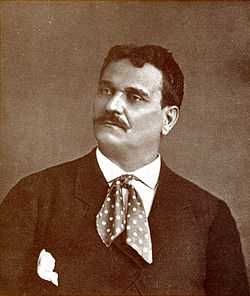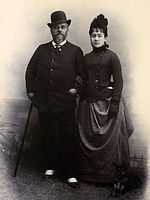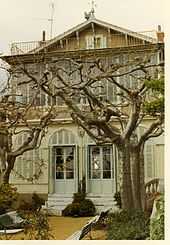Jean-Vital Jammes

Jean-Vital Jammes (known by the stage name Ismaël) (28 April 1825 – 13 June 1893)[1] was a French opera singer. During a stage career spanning 40 years, he created many leading baritone roles, including Zurga in Bizet's Les pêcheurs de perles and Ourrias in Gounod's Mireille. Born in Le Passage d'Agen near the town of Agen, he was largely self-taught and made his stage debut in 1841 at the age of 16. After singing in a several provincial theatres, he was engaged by the Théâtre Lyrique in Paris and later by the Opéra-Comique. Following his retirement from the stage, Ismaël lived in Marseille where he died at the age of 68.
Biography
Early life and career
Ismaël was born Jean-Vital Jammes, the son of an illiterate tailor in Le Passage near the town of Agen.[2] He showed an early interest in singing and as a teenager developed a beautiful baritone voice. However, his family were too poor to afford any kind of music lessons for him, and at the age of sixteen he left home to earn a living as a street singer, working his way on foot to Bordeaux and then Nantes.[3] At Nantes, he was taken on as a chorister at the opera house during the season 1842-1843 and before his 17th birthday achieved local success when he stepped in at the last minute to sing the role of Max in a production of Adam's Le chalet[4] He then set off for Paris hoping to further his training as a singer, but he was virtually illiterate and was refused admittance to the Paris Conservatory. Instead, he taught himself to read and write and took a few singing lessons from an unknown teacher. He worked largely on his own to learn the music for the major baritone roles of his day and managed to secure a position singing baritone and bass roles in a small opera house at Verviers in Belgium.[5] He soon returned to France and after performing in several small provincial theatres as well as the Opéra de Marseille, where he appeared each season between 1854 and 1860, he was engaged on a permanent contract by the Opéra de Rouen. At Rouen, he appeared with great success in a series of leading roles between 1862 and 1863 and came to the attention of the impresario Léon Carvalho.
On the Paris stage

In 1862, Ismaël was engaged by Carvalho for his Théâtre Lyrique company in Paris. Ismaël's time with the company marked the peak of his career. His debut on 30 September 1863 was as Zurga in the premiere of Bizet's Les pêcheurs de perles. This was followed by appearances beginning on 24 December in the title role of Verdi's Rigoletto, a new production which was highly successful and established Ismaël as one of the leading singers in the French capital.[6] He also created the role of Ourrias in Gounod's Mireille and sang the title role in Verdi's Macbeth for the premiere of its revised version on 21 April 1865.[7] Other roles included the title role in Donizetti's Don Pasquale, Falstaff in Nicolai's The Merry Wives of Windsor,[8] and Sganarelle in Gounod's Le médecin malgré lui (1866).[9] Ismaël stayed with the Théâtre Lyrique until Carvalho went bankrupt in 1868. He then sang at the Opéra de Marseille before returning to Paris in 1871 to join the Opéra-Comique at the Salle Favart, where he sang in the premieres of several more operas and operettas including Offenbach's Fantasio and Delibes' Le roi l'a dit as well as the company's first performances of Gounod's Roméo et Juliette (as Frère Laurent) and Le médecin malgré lui (as Sganarelle).[10]

Le Trombinoscope, 1877
Later career
In the mid-1870s, vocal problems attributed to laryngitis caused him to retire from the Opéra-Comique.[11] He was appointed Professor of Lyric Declamation (Opera) at the Paris Conservatory on 1 February 1874, but on 23 December 1876 he was abruptly dismissed from his post without explanation. Ismaël repeatedly, but unsuccessfully, asked for a public investigation into the affair.[12][13] Following his dismissal from the conservatory and the subsequent loss of his salary there, he returned to the stage appearing in comic operas and operettas at the Théâtre du Casino in Monte Carlo and the Théâtre de la Renaissance in Paris until 1880. In 1877, the year in which Ismaël appeared in the premiere of the Strauss operetta La tzigane at the Théâtre de la Renaissance,[14] the satirical revue Le Trombinoscope devoted an entire issue to him with a biography by "Touchatout" (Léon-Charles Bienvenu). He went on to appear in two more world premieres at the Théâtre de la Renaissance—Lecocq's La jolie persane in 1879 (as Nadir) and Planquette's Les voltigeurs de la 32ème in 1880 (as Richard). Amongst his performances at the Théâtre du Casino in Monte Carlo was the title role in Planquette's Le chevalier Gaston for its world premiere in 1879.[10]
Marriage and retirement years

His pupils included Max Bouvet and Jean Delvoye.

Ismaël married twice, first at the age of 27 to the soprano Alceste Anastasie Hortense Cœuriot (also known by the first name "Anaïs"). The couple were both singing at the Grand Théâtre de Lyon at the time of their marriage in 1852, after which Alceste appeared under the last name "Ismaël".[15] They were divorced in 1885 after years of living apart,[16] and shortly thereafter he married Marie Garcin (1858–1946), a young opera singer who had been one of his pupils. The following year, he brought a lawsuit against his first wife to prevent her from continuing to perform under his last name but was unsuccessful. At the time of the court case (May 1886), and much to the onstage consternation of Alceste, both she and his second wife found themselves singing in the same production of Faust at the Théâtre du Capitole in Toulouse—Alceste Ismaël as Marguerite and Marie Ismaël-Garcin as Marguerite's guardian, Marthe.[17]
According to Étienne Destranges, writing in Le Théâtre à Nantes, Marie Ismaël-Garcin had been a singer of great promise and achieved a considerable success in Nantes as Dinorah in Meyerbeer's Le pardon de Ploërmel, but by 1889 her light voice was already in decline.[18] Ismaël spent the last years of his life with Marie at his villa in Marseille and gave private singing lessons. The villa, which he had bought in 1861, still exists and is situated in the Roucas-Blanc neighborhood on the Traverse Ismaël (named after him). A public staircase, the Escalier du Prophète, leads from the Traverse Ismaël to the beach, Plage du Prophète. According to local newspapers, the staircase and beach took their name from Meyerbeer's opera Le prophète, which Ismaël would often practice on the beach.
Jean-Vital Jammes died in Marseille on 13 June 1893 at the age of 68.[1][19] Marie Garcin never remarried and lived in the villa for the rest of her life. She died at her home in 1946 and is buried with her husband in the family tomb at the Cimetière Saint-Pierre in Marseille.[20]
Roles created
Ismaël is known to have created the following roles:[21]
- Zurga in Bizet's Les pêcheurs de perles (Théâtre-Lyrique du Châtelet, Paris, 30 September 1863)
- Ourrias in Gounod's Mireille (Théâtre-Lyrique du Châtelet, Paris, 19 March 1864)
- Quirino in Poniatowski's L'aventurier (Théâtre-Lyrique du Châtelet, Paris, 26 January 1865)[22]
- Giaffir in Adrien Barthe's La fiancée d'Abydos (Théâtre-Lyrique du Châtelet, Paris, 30 December 1865)
- Cardillac in Lucien Dautresme's Cardillac (Théâtre-Lyrique du Châtelet, Paris, 11 December 1867)
- Prince of Mantua in Offenbach's Fantasio (Opéra-Comique, Paris 18 January 1872)
- Marquis Moncontour in Delibes' Le roi l'a dit (Opéra-Comique, Paris, 24 May 1873)
- Andrea Galeotti in Charles Lenepveu's Le Florentin (Opéra-Comique, Paris, 25 February 1874)
- Gille in Ambroise Thomas' Gille et Gillotin (Opéra-Comique, Paris, 22 April 1874)
- Matthias in Strauss' La tzigane (Théâtre de la Renaissance, Paris, 30 October 1877)
- Gaston in Planquette's Le chevalier Gaston (Théâtre du Casino, Monte Carlo, 8 February 1879)
- Nadir in Lecocq's La jolie persane (Théâtre de la Renaissance, Paris, 28 October 1879)
- Richard in Planquette's Les voltigeurs de la 32ème (Théâtre de la Renaissance, Paris, 7 January 1880)
Performances at the Grand Théâtre, Marseille 1854-1860
Ismaël first sang at Marseille's Grand-Théâtre (or Salle Bauveau) in 1854 during Provini's second management of the theatre. He continued to perform there for six seasons in the following operas:[23]
- Meyerbeer's L'étoile du nord, 30 December 1854 (as Gritzenko; Alceste Cœuriot was also in the cast)
- Poise's Bonsoir voisin, 8 January 1855
.jpg)
- Clapisson's La Promise, 9 March 1855
- Agnelli's Léonore de Médicis, 23 March 1855
- Grisar's Le chien du jardinier, 21 October 1855
- Ernest Boulanger's Les sabots de la marquise, 21 November 1855
- Donizetti's Linda di Chamounix, 17 December 1855
- Count di Luna in Verdi's Le trouvère, 22 February 1856
- Donizetti's Marino Faliero, 14 March 1857 (Luigi Merly was also in the cast)
- Charles V in Verdi's Ernani, 12 February 1858
- Auber's Marco Spada, 14 April 1858
- Bazin's Maître Pathelin, 12 November 1858
- Flotow's Martha, 15 December 1858
- Maillart's Les dragons de Villars, 21 January 1859 (as Sergeant Belamy)
- Gounod's Le médecin malgré lui, 7 March 1859
- Gevaert's Quentin Durward, 15 November 1859
- Halévy's Jaguarita l'Indienne, 6 February 1860
- Morel's Le jugement de Dieu, 7 March 1860
- Verdi's Rigoletto, 12 May 1860 (Marie-Stéphanie Meillet, Armandi, Depassio were also in the cast)
Performances at the Théâtre des Arts, Rouen 1862-1863
Ismaël is known to have sung in the following performances at the Théâtre des Arts (Rouen):[24]
- Rossini's Guillaume Tell, 15 September 1862
- Rossini's Le barbier de Seville
- Donizetti's Lucie de Lammermoor, 18 September 1862
- Maillart's Les dragons de Villars (Pauline Borghese and Bouvard from the Théâtre Lyrique were also in the cast)
- Verdi's Le trouvère, late 1862
- Verdi's Rigoletto, 3 December 1862 (Irène Lambert, the tenor Mazerini, the bass Valette, and Célestine Galli-Marié were also in the cast)
- Adam's Si j'étais roi, early 1863 (replacing the baritone Villefroy)
- Balfe's La bohémienne,[25] 1863 (replacing Bonnasseur)
- Meyerbeer's Les Huguenots, 1863 (the tenor Depassio was also in the cast)
- Gaveaux's Le bouffe et le tailleur
- Auber's La fiancée, 22 March 1863[26]
- Verdi's Ernani
- Mozart's Les noces de Figaro (Célestine Galli-Marié was also in the cast)
References
Notes
- ↑ 1.0 1.1 Birth name and life dates are from Pierre (1900) p. 447. See also the Birth certificate of Jean-Vital Jammes. Pougin (18 June 1893) p. 200 and Vapereau (1870) p. 943 give his year of birth as 1827.
- ↑ In several sources, his name is given as Jean-Vital-Ismaël Jammes, including Fétis and Pougin (1880) p. 13. According to Vapereau (1870) p. 943 , his parents were Jewish: "de parents Israélites".
- ↑ Fétis and Pougin (1880) pp. 13-14; New York Times (1 July 1893)
- ↑ Destrange, Etienne (1893).
- ↑ Vapereau (1870) p. 943
- ↑ Kutsch and Riemens (2003) p. 2202; Walsh (1981) p. 317
- ↑ Walsh (1981) pp. 317, 318
- ↑ Walsh (1981) pp. 317, 319
- ↑ Kutsch & Riemens (2003) p. 2202; short review in Le Ménestrel vol. 33, no. 44 (30 September 1866), p. 347: "Ismaël avait à effacer d'excellents souvenirs [de Meillet et Sainte-Foy], et c'est double mérité à lui d'avoir réussi dans le rôle de Sganarelle. Il y est bon comédien...."
- ↑ 10.0 10.1 Casaglia (2005)
- ↑ New York Times (1 July 1893); Fétis and Pougin (1880) pp. 13-14
- ↑ Pierre (1900) p. 447
- ↑ Fétis and Pougin (1880) pp. 13-14; Heylli (1887) p. 205.
- ↑ La tzigane was a pastiche operetta with a French libretto and music from Strauss' Die Fledermaus and Cagliostro in Wien.
- ↑ In French sources, Cœuriot's voice is described as "Dugazon", which was used to refer to light voiced singers in the high mezzo-soprano range or sopranos with a dark timbre to their voice. The couple were married on 24 January 1852 in La Guillotière, a commune of Lyon. See Lyon municipal archives. Marriage Register, Commune of La Guillotière, 1852, p. 18. Retrieved 21 February 2012.
- ↑ Divorce did not become legal in France until 1884.
- ↑ Rivière (1887) pp. 6-8; Silvestre (1886) p. 213
- ↑ Destranges (1902) pp. 240-241
- ↑ Pougin (18 June 1893) p. 200
- ↑ The tomb is situated in "Carré 17 Est - 4e rang - N° 28 - Concession N° 3 479".
- ↑ Information is from Casaglia (2005) unless otherwise noted.
- ↑ Walsh 1981, p. 318; review in Le Ménestrel vol. 32, no. 9 (29 January 1865), p. 67. Casaglia mistakenly places this premiere at the Salle Ventadour of the Théâtre-Italien.
- ↑ Unless otherwise specified, this section is sourced from the obituary of Jean-Vital Jammes in Le Petit Provençal, June 1893 (see Commons:Category:Jean-Vital Jammes obituary Petit Provençal). The dates given are for Ismaël's first performance in the opera at the Grand-Théâtre.
- ↑ Unless otherwise specified, this section is sourced from the obituary of Jean-Vital Jammes in Le Journal de Rouen (June 1893) (see Commons:Category:Jean-Vital Jammes obituary Le journal de Rouen)
- ↑ This is a highly adapted French version of Balfe's opera. See this paragraph in the article Théâtre Lyrique for additional details.
- ↑ Élart 2004, p. 131.
Sources
- Casaglia, Gherardo (2005).[http://www.amadeusonline.eu/almanacco.php?Testo=Jean-Vital_Jammes&Parola=Stringa "Jean-Vital Jammes"]. Almanacco Amadeus (Italian).
- Destranges, Étienne (1902). Le Théâtre à Nantes: depuis ses origines jusqu'à nos jours. Fischbacher (French)
- Élart, Joann (2004). Catalogue des fonds musicaux conservés en Haute-Normandie: Tome I : Bibliothèque municipale de Rouen. Vol. I : Fonds du Théatre des arts, 18e et 19e sicèles Mont-Saint-Aignan (Seine-Maritime): Publications de l'Université de Rouen. ISBN 978-2-87775-333-3.
- Fétis, François-Joseph and Pougin, Arthur (1880). "Ismaël (Jean-Vital-Ismaël Jammes)", Biographie universelle des musiciens. Supplément et complément, Vol. 2. pp. 13–14. Firmin-Didot (French). Copy at Google Books.
- Heylli, Georges d' (1887). "Ismaël", Dictionnaire des pseudonymes, p. 205. Dentu (French)
- Kutsch, K. J.; Riemens, Leo (2003). Grosses Sängerlexikon (fourth edition, in German). Munich: K. G. Saur. ISBN 978-3-598-11598-1.
- New York Times (1 July 1893). "Obituary: Jean Vital Jammes"
- Pierre, Constant, editor (1900). Le Conservatoire national de musique et de déclamation. Documents historiques et administratifs. Paris: Imprimerie National.
- Pougin, Arthur (18 June 1893). "Nécrologie", Le Ménestrel, Vol. 59, No. 25, p. 200 (French)
- Rivière, Hippolyte-Ferréol (1887). "Acteurs: Propriété des noms et pseudonymes", Pandectes françaises : nouveau répertoire de doctrine, de législation et de jurisprudence, Volume 2, pp. 6–8 . Chevalier-Marescq (French)
- Silvestre, Armand (1886). "Deux femmes pour un mari" (originally published in Gil Blas), Georges d'Heylli (ed.) Gazette anecdotique, littéraire, artistique et bibliographique, Vol. 1, p. 213. Librairie des bibliophiles (French)
- Vapereau, Gustave (1870). "Ismaël (Jean-Vital-Ismaël Jammes)", Dictionnaire universel des contemporains, Vol. 2, p. 943. Hachette (French)
- Walsh, T. J. (1981). Second Empire Opera: The Théâtre Lyrique Paris 1851–1870. New York: Riverrun Press. ISBN 978-0-7145-3659-0.
External links
| Wikimedia Commons has media related to Jean-Vital Jammes. |